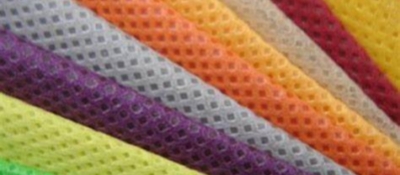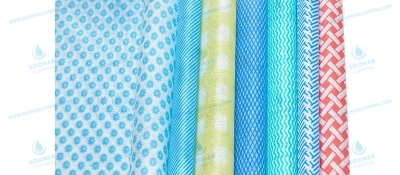Home>News
What is the difference between spunlace and spunbond? Distinguish from these aspects
- 2024-09-20
Spunlace nonwovens are also called "jet spunlace fabrics". The concept of "jet spunlace fabrics" comes from the mechanical needle punching process. The so-called "jet spunlace" is to use high-pressure water flow to penetrate the fiber web, so that the fibers are entangled with each other, so that the original loose fiber web of spunlace nonwoven fabric has a certain strength and complete structure.
The general spunlace process is: fiber metering and mixing-opening and removing impurities-mechanical random combing into a web-fiber web pre-wetting-water needle intertwining-surface treatment-drying-winding-inspection-packaging and storage. The spunlace device uses high-speed high-pressure water flow to spray the fiber web, so that the fibers in the fiber web are rearranged and entangled with each other, forming a non-woven fabric with a complete structure and certain strength and other properties. The physical properties of this spunlace non-woven bag are different from those of common needle-punched non-woven fabrics. Whether in terms of hand feel and microfiber non-woven fabric performance, it is the only non-woven fabric that can make its final product similar to textiles.
There is no squeezing of the fiber web in the spunlace process, which increases the bulkiness of the final product. No resin or adhesive is used, which maintains the inherent softness of the fiber web. The high integrity of the spunlace product avoids the fluffy phenomenon of the product. The fiber web has a high mechanical strength, which can reach 80%~90% of the strength of textiles; the fiber web can be mixed with any type of fiber. It is particularly worth mentioning that the spunlace fiber web can be compounded with any base fabric to make a composite product. Products with various functions can be produced according to different uses.
Characteristics of spunlace fabric:
Soft, good drape, good strength, high moisture absorption and quick wetting, lint free, washable, no chemical additives, and similar appearance to textiles.
Due to the advantages of spunlace fabric, it has become one of the fastest technological advances in the non-manufacturing industry in recent years. The development direction of non-woven fabrics is to replace textiles and knitwear. Spunlace fabrics have become the most potential field to compete with the textile market with their most textile-like characteristics, excellent physical properties, and good quality and low price.
Applications of spunlace fabrics:
1. Medical: disposable surgical gowns, surgical drapes, surgical tablecloths, water-repellent fabrics, surgical aprons, etc., wound dressings, bandages, gauze, Band-Aids, etc.;
2. Clothing: clothing linings, baby clothes, training clothes, disposable colorful clothes for carnival night, various protective clothing, etc.;
3. Wipes: household, personal, beauty, industrial, medical dry and wet wipes, etc.;
4. Decorative fabrics: automotive interiors, home interiors, stage decorations, etc.;
5. Agricultural: insulation greenhouses, weed control, harvest cloth, insect-proof and fresh-keeping cloth, etc.;
6. Spunlace non-woven fabrics can also be used for composite processing, and can produce "sandwich" type structure products and develop new composite materials for multiple uses.
SPUNBONDSpunbond non-woven fabrics are formed by extruding and stretching the polymer to form continuous filaments, and the filaments are laid into a net. The fiber net is then bonded, thermally bonded, chemically bonded or mechanically reinforced to make the fiber net into a non-woven fabric.

Spunbond is also known as melt spinning web forming method. It uses chemical fiber spinning method. In the process of polymer spinning, the extruded melt filaments are cooled by quenched air, so that the filaments are stretched by the stretching air flow during the cooling process to form continuous filaments, and then formed into a web on the condensing curtain, and laid on the forming curtain, and then processed by the consolidation device to form spunbond nonwoven fabrics. This method is a one-step fabric forming nonwoven technology. Spunbond nonwoven fabric technology not only has unique characteristics in terms of process route and equipment structure, but also the processed products have their own characteristics.
Characteristics of spunbond nonwoven fabrics:
High strength, good high temperature resistance (can be used for a long time in an environment of 150℃), aging resistance, UV resistance, high elongation, good stability and air permeability, corrosion resistance, sound insulation, mothproof, non-toxic.
The main raw materials and uses of spunbond nonwovens:
The raw materials used in spunbond nonwovens are mainly polypropylene (PP), polyester (PET) and polyamide (PA). Due to the high spinning speed, the crystallinity and orientation of fine fibers are also high, and the fibers have good heat shrinkage and heat resistance.
1.PP is the most widely used resin in spunbond production. It has the characteristics of low melting point, high strength, good chemical properties and low price. It is suitable for processing sanitary napkins, diapers and packaging materials, etc.
2.PET is a resin second only to PP in spunbond production. It has the characteristics of high strength, weather resistance and good comprehensive performance. It is mainly used for products with high use value. According to different reinforcement methods, the sliced raw materials can use homopolymers and copolymers. It is suitable for processing agricultural fabrics, packaging materials, construction and roofing materials, etc.
3.PA6 and PA66 have the advantages of good hygroscopicity, good dyeability and wear resistance, but due to their high prices, they are less used.
How to distinguish spunlace nonwovens from spunbond nonwovens?
Distinguishing spunlace nonwovens from spunbond nonwovens can be done from the following aspects:
Touch:
Spunlace nonwovens: soft, delicate, and comfortable to the touch.
Spunbond nonwovens: relatively hard and rough to the touch.
Breathability:
Spunlace nonwovens: good breathability, suitable for cleaning products.
Spunbond nonwovens: slightly poor breathability, mainly used in waterproof occasions.
Weight:
Spunbond fabrics are lighter than spunlace nonwovens.
Fibers (tear open the nonwoven fabric to check the internal fibers):
Spunbond fabrics generally use long fibers, which are used for wet wipes and face towels
Spunlace fabrics such as wet toilet paper generally use short fibers
Water absorption:
Spunlace nonwovens: strong water absorption, can quickly absorb water.
Spunbond nonwovens: weak water absorption, mainly used for waterproofing or barrier.
Appearance:
Spunlace nonwovens: most plain spunlace fabrics have very fine longitudinal spunlace patterns; jacquard spunlace fabrics have uneven patterns.
Spunbond nonwoven fabric: Some small rolling points can be seen on the fabric surface.
Strength:
Spunlace nonwoven fabric: Moderate strength.
Spunbond nonwoven fabric: Relatively stronger, suitable for bearing greater tension.




